Key Takeaways
- Discover the top courier software of 2025, highlighting advanced route optimization, real-time tracking, and seamless integrations for enhanced delivery efficiency.
- Understand key features, pricing models, and user reviews to select the best software tailored to your business size and delivery needs.
- Learn how innovative technologies like AI and automation in courier software improve customer satisfaction and operational scalability globally.
The courier industry is undergoing a profound transformation in 2025, driven by the exponential growth of e-commerce, shifting consumer expectations, and rapid technological advancements. As online shopping continues to dominate global retail markets, the demand for faster, more reliable, and transparent delivery services has never been greater. This surge in volume and complexity has elevated the importance of courier software as an essential tool for logistics providers, enabling them to optimize operations, improve customer satisfaction, and maintain a competitive edge in an increasingly crowded marketplace.

Courier software solutions in 2025 go far beyond basic tracking and dispatching functions. They integrate advanced features such as artificial intelligence-driven route optimization, real-time driver and package tracking, automated customer notifications, and digital proof of delivery systems. These capabilities allow courier companies to streamline their workflows, reduce delivery times, cut operational costs, and enhance overall service quality. Moreover, the rise of omnichannel retailing and on-demand delivery models requires software platforms that are scalable, flexible, and capable of seamless integration with other business systems like e-commerce platforms, CRM tools, and payment gateways.
This comprehensive global analysis explores the top 11 best courier software platforms of 2025, evaluating them based on their technological sophistication, ease of use, feature set, scalability, pricing, and user satisfaction. Each software solution is assessed for its ability to meet the diverse needs of businesses ranging from small local delivery services to large enterprise logistics providers. By examining key functionalities such as route planning algorithms, real-time visibility, customer communication tools, proof of delivery options, and data analytics capabilities, this analysis aims to provide businesses with critical insights to make informed decisions when selecting the optimal courier software to drive efficiency and growth.
In a market where efficiency, transparency, and customer experience are paramount, choosing the right courier software is a strategic investment. The platforms reviewed here represent the forefront of innovation and operational excellence, offering solutions that can adapt to evolving market demands and technological trends. Whether a business seeks to enhance last-mile delivery, improve driver coordination, or elevate customer engagement, understanding the strengths and unique offerings of these top courier software providers is essential. This detailed evaluation not only highlights the best tools available but also underscores the transformative impact of courier software on the logistics industry in 2025 and beyond.
Before we venture further into this article, we would like to share who we are and what we do.
About 9cv9
9cv9 is a business tech startup based in Singapore and Asia, with a strong presence all over the world.
With over nine years of startup and business experience, and being highly involved in connecting with thousands of companies and startups, the 9cv9 team has listed some important learning points in this overview of The Top 11 Best Courier Software in 2025.
If your company needs recruitment and headhunting services to hire top-quality employees, you can use 9cv9 headhunting and recruitment services to hire top talents and candidates. Find out more here, or send over an email to [email protected].
Or just post 1 free job posting here at 9cv9 Hiring Portal in under 10 minutes.
Top 11 Best Courier Software in 2025: A Comprehensive Global Analysis
- CXT Software
- Dispatch Science
- Detrack
- Route4Me
- OnTime 360
- Routific
- Track-POD
- Upper Inc (Upper Route Planner)
- Shipday
- Parcel Tracker Mailroom (Deepfinity)
- Onfleet
1. CXT Software
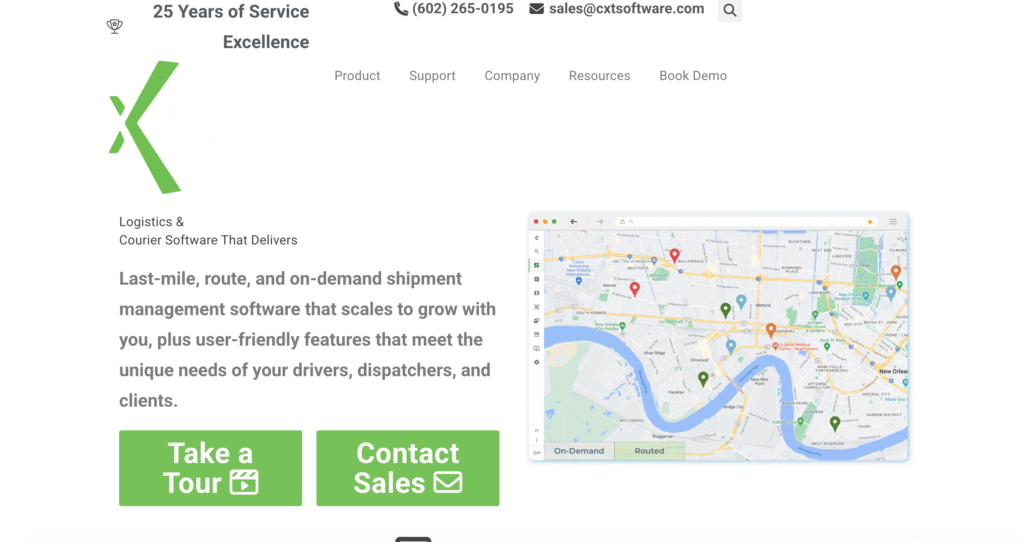
CXT Software stands out as one of the leading courier software platforms in 2025, offering a deeply experienced and technologically advanced solution tailored for the logistics and courier industry. The company’s extensive history, comprehensive features, and strategic growth initiatives contribute to its prominent position in the global courier software landscape.
Overview and Industry Standing
- Founded in 1999 and based in Phoenix, Arizona, CXT Software brings more than 25 years of specialized experience in courier and logistics dispatch software, primarily serving the North American market.
- The company’s longevity underscores a profound understanding of the complex operational challenges couriers face, making its solutions highly aligned with real-world industry demands.
- In early 2025, the acquisition by Ionic Partners, a respected enterprise software investment firm, marked a significant milestone, positioning CXT Software for accelerated innovation and expansion within the competitive logistics technology sector.
- With a focused team of 52 employees, the company maintains a balance between operational agility and industry expertise.
Comprehensive Feature Suite
- CXT Software provides an integrated all-in-one platform designed to optimize every stage of courier and delivery workflows.
- Core capabilities include:
• Advanced route planning to ensure efficient delivery paths that reduce fuel costs and improve delivery times.
• Real-time live tracking functionality that enhances transparency for both operators and end customers.
• Seamless customer communication tools designed to maintain engagement and provide updates throughout the delivery process. - Industry versatility is notable, with specialized support for sectors such as medical and laboratory deliveries, bulky shipments, and general pick-up and delivery services.
- Dispatch management tools allow logistics managers to oversee and allocate routes effectively, while the advanced driver application equips delivery personnel with essential tools for success, including job status updates and navigation support.
- The client portal adds a layer of transparency, enabling customers to monitor their shipments with live updates, fostering improved customer satisfaction and trust.
- Additional operational features include:
• Barcode scanning for streamlined package handling and verification.
• Integrated billing and invoicing systems to simplify financial workflows.
• Customer database management to maintain detailed client records.
• Job assignment automation to enhance dispatch accuracy and efficiency.
• Label printing and order entry capabilities to reduce administrative overhead.
• Robust routing and scheduling tools that adapt dynamically to changing delivery conditions.
Pricing Structure and Market Position
- Starting at $340 per month, CXT Software targets mid-sized to larger courier operations that require a scalable and comprehensive platform.
- This pricing model supports flexibility with a subscription-based approach, allowing companies to access a wide array of features without the constraints of long-term contracts.
- The solution’s cost positioning reflects its advanced functionality and enterprise-grade capabilities, making it suitable for businesses prioritizing robust performance and scalability.
User Ratings and Feedback Analysis
- CXT Software’s recognition as a SourceForge Top Performer in Spring 2025 reflects its consistent delivery of high user satisfaction.
- On G2, it holds a respectable rating of 4.1 out of 5 stars, based on 4 user reviews, highlighting positive perceptions around ease of use and the breadth of functionalities offered.
- Constructive user feedback has pointed out occasional software instability and slower load times, which indicates potential areas for technical refinement to enhance user experience.
- The platform has also garnered substantial engagement on Slashdot, with 63 ratings, signaling significant community involvement and validation of its capabilities.
Operational Capacity and Scalability
- CXT Software has demonstrated its ability to manage large-scale transitions, exemplified by a successful migration of over 1,400 customers for a single client, showcasing the platform’s robustness and scalability.
- With a mid-sized team of 52 employees, the company maintains sufficient operational capacity to support client needs while focusing on continuous product improvement.
Summary Assessment
- CXT Software excels as a comprehensive, feature-rich courier management platform with over two decades of industry experience.
- Its strengths lie in its all-encompassing service offerings, real-time tracking, and customer engagement tools, all tailored for mid-to-large sized courier, last-mile, and less-than-truckload (LTL) logistics providers operating predominantly in North America.
- While the platform commands a higher price point, it justifies this with scalable, enterprise-grade features designed to enhance operational efficiency and customer satisfaction.
- Prospective users should consider reported performance issues but can expect a solution backed by significant user engagement and proven capacity for managing complex logistics operations.
Comparison Table: CXT Software Key Attributes
| Feature | Description | Benefit |
|---|---|---|
| Route Planning | Advanced algorithmic optimization for delivery routes | Reduces operational costs, improves speed |
| Live Tracking | Real-time shipment visibility | Enhances customer transparency and trust |
| Driver Application | Mobile tools for delivery personnel | Improves delivery accuracy and communication |
| Client Portal | Customer access to shipment updates | Increases customer satisfaction |
| Billing & Invoicing | Integrated financial management | Streamlines payment processing |
| Barcode Scanning | Package verification and handling | Minimizes errors and expedites processing |
| Job Assignment Automation | Dispatch route and task allocation | Enhances operational efficiency |
| Label Printing & Order Entry | Administrative support functions | Reduces manual workload |
| Scalability | Supports large-scale migrations and growing fleets | Suitable for mid-large enterprises |
This detailed analysis underscores why CXT Software remains a top contender in the 2025 courier software market, driven by its mature technology, comprehensive features, and strategic growth initiatives.
2. Dispatch Science

Dispatch Science emerges as a formidable contender within the courier software arena in 2025, distinguished by its advanced delivery management capabilities and strategic focus on organic growth. Despite being a relatively recent entrant, the platform has rapidly gained recognition for its robust features and operational efficiency, making it a pivotal solution for complex logistics challenges on a global scale.
Company Background and Market Position
- Founded in 2016 and headquartered in Montreal, Canada, Dispatch Science has quickly carved out a niche by delivering sophisticated delivery management solutions tailored for modern courier and logistics operations.
- Operating as an unfunded company, Dispatch Science emphasizes organic growth, which suggests a focus on sustainable development and delivering genuine value rather than relying on external capital injections.
- With a lean team size of approximately 11 to 50 employees, the company balances agility and expertise, enabling rapid innovation while maintaining personalized client engagement.
Comprehensive Platform Features and Industry Applications
- Dispatch Science offers an all-encompassing Transport Management System (TMS) engineered to automate and optimize the entire delivery lifecycle. Key functionalities include:
• Order booking and customer relationship management (CRM) facilitated through a user-friendly self-service customer portal.
• Advanced pricing models that adapt to diverse delivery scenarios.
• Sophisticated route optimization algorithms designed to minimize transit times and reduce operational costs.
• Real-time shipment tracking enriched with predictive estimated time of arrivals (ETAs), enabling proactive delivery management.
• Returns management and proof of delivery functionalities that enhance operational accountability and customer trust.
• Barcode scanning to streamline package handling and verification processes.
• Integrated billing modules to simplify financial reconciliation.
• Extensive driver management features accessible via native iOS and Android applications, ensuring seamless communication and performance tracking in the field. - The platform’s versatility is demonstrated by its applicability across a broad spectrum of industries including:
• Courier and parcel delivery services.
• E-commerce last-mile logistics, where speed and accuracy are paramount.
• Manufacturing distribution channels requiring precise inventory movement.
• Third-party logistics (3PL) providers managing multi-client delivery networks.
• Restaurant and food and beverage distribution with strict time and quality constraints.
• Medical and pharmaceutical logistics necessitating compliance and traceability.
• Retail last-mile delivery optimizing customer satisfaction and operational efficiency. - Dispatch Science further enhances integration capabilities through an open API, facilitating seamless connectivity with third-party systems such as accounting software and e-commerce platforms, thereby enabling cohesive digital ecosystems.
Pricing Strategy and Target Market
- Dispatch Science’s pricing starts at $675 per month, reflecting its positioning towards enterprises requiring sophisticated, scalable delivery solutions.
- An enterprise-level plan is offered to accommodate clients with highly complex or large-scale operational demands, underlining the platform’s flexibility and customization potential.
- The premium pricing structure aligns with the software’s advanced functionalities and its value proposition to organizations that prioritize operational excellence and automation.
User Feedback and Performance Metrics
- On G2, Dispatch Science commands a strong rating of 4.5 out of 5 stars, based on 12 detailed user reviews, illustrating widespread satisfaction with its comprehensive feature set and efficiency improvements.
- Positive user testimonials emphasize:
• The platform’s ability to automate routine processes, significantly reducing manual workload.
• Effective route optimization that translates into operational cost savings and improved delivery punctuality.
• Robust tracking and predictive ETA tools that enhance visibility and customer communication. - Conversely, users have highlighted:
• A relatively steep learning curve, which may require dedicated onboarding and training resources.
• The elevated monthly subscription cost, which may present a barrier for smaller or budget-constrained operations. - A notable case study reveals that a client achieved a 99% on-time delivery rate alongside a 28% reduction in operational costs following the implementation of Dispatch Science, demonstrating the platform’s tangible impact on logistics performance.
Quantitative Insights and Community Engagement
- The platform has garnered 22 user ratings on Slashdot, indicating active community involvement and a breadth of evaluative feedback.
- These metrics collectively validate Dispatch Science’s capacity to deliver meaningful efficiency gains and operational reliability in demanding delivery environments.
Summary Evaluation and Ideal Use Cases
- Dispatch Science presents a technologically sophisticated and feature-rich courier management system designed for organizations with complex delivery requirements across diverse industry verticals.
- Its strengths lie in advanced route optimization, process automation, and comprehensive delivery lifecycle management.
- The higher price point and complexity of implementation necessitate consideration by prospective clients, who should balance these factors against the potential operational efficiencies and cost savings.
- The software is optimally suited for larger courier firms, 3PL providers, and enterprises seeking a scalable, integrated platform capable of managing intricate logistics operations with precision.
Dispatch Science Feature Matrix
| Feature | Description | Strategic Benefit |
|---|---|---|
| Transport Management System | Comprehensive order, delivery, and CRM integration | Streamlines entire delivery workflow |
| Route Optimization | Predictive and adaptive routing algorithms | Minimizes delivery time and fuel consumption |
| Real-Time Tracking | Live shipment visibility with predictive ETAs | Enhances operational transparency and planning |
| Returns Management | Efficient handling of returns and reverse logistics | Improves customer satisfaction and reduces losses |
| Mobile Driver Apps | iOS and Android apps with delivery management tools | Facilitates field operations and communication |
| Self-Service Customer Portal | Enables clients to book orders and track deliveries | Increases customer autonomy and reduces support calls |
| Open API | Seamless integration with third-party systems | Supports custom workflows and system interoperability |
| Billing and Invoicing | Automated financial processing | Simplifies accounting and improves cash flow |
| Barcode Scanning | Package verification and tracking | Reduces errors and speeds up handling |
Dispatch Science’s ability to blend comprehensive delivery management, cross-industry applicability, and scalable integration frameworks establishes it as one of the top courier software solutions globally in 2025. Its focus on automation and precision makes it a strategic asset for organizations committed to elevating their logistics performance.
3. Detrack
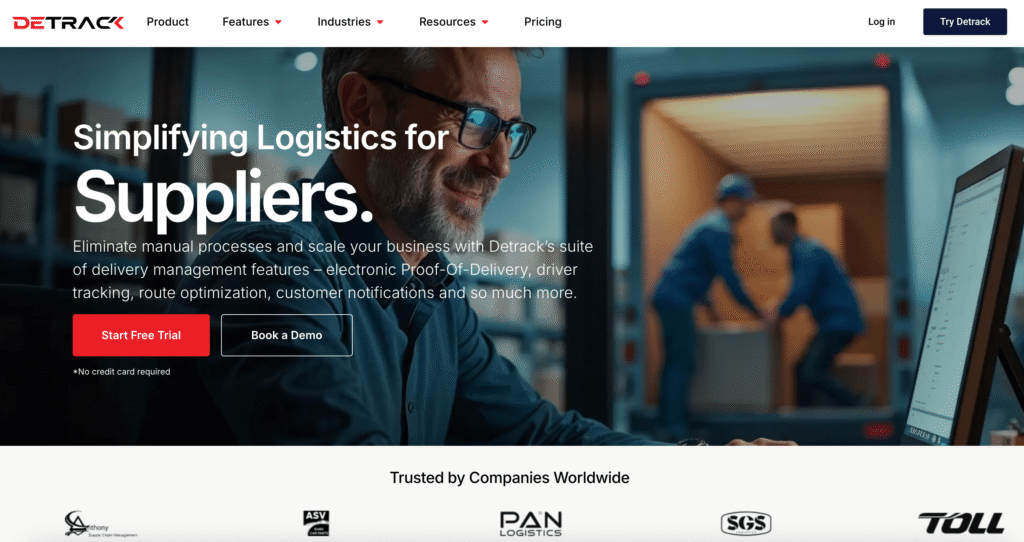
Detrack has firmly established itself as a leading courier software solution in 2025, recognized globally for its innovative combination of vehicle tracking and real-time electronic proof-of-delivery (POD) capabilities. Originating from Singapore in 2013, Detrack’s cloud-based Software as a Service (SaaS) platform has rapidly expanded its international footprint, catering to a diverse range of businesses with its cost-effective, scalable, and highly functional delivery management system.
Company Profile and Global Reach
- Founded in 2013 in Singapore, Detrack operates as an unfunded company, emphasizing sustainable, organic growth over venture capital dependence.
- The company boasts a compact yet proficient team of 22 employees, reflecting a focused organizational structure dedicated to continuous product enhancement and customer support.
- Detrack’s mobile application has achieved remarkable adoption, with over 200,000 downloads spanning 45 countries, illustrating widespread trust and relevance in diverse geographic markets.
Core Functionalities and Operational Benefits
- Detrack delivers comprehensive control over last-mile delivery operations, integrating vehicle tracking with instantaneous electronic proof-of-delivery (POD) to ensure transparency and accountability.
- The platform captures critical delivery data, including:
• Customer signatures verifying receipt.
• Accurate timestamps marking job completion.
• Photographic evidence supporting proof of service, including images of successful deliveries or reasons for failed or rejected jobs. - Automated SMS/text notifications enhance customer communication by providing real-time updates at various delivery stages:
• Pre-delivery alerts preparing recipients.
• On-route notifications to manage expectations.
• Post-delivery confirmations validating successful service. - Beyond core tracking and notification features, Detrack integrates:
• Route optimization tools that streamline delivery paths, reducing fuel consumption and transit times.
• Dispatch management systems enabling efficient assignment and oversight of delivery personnel.
• Driver management capabilities fostering improved workforce productivity.
• Robust reporting functionalities delivering actionable insights into delivery performance and operational efficiency. - The platform supports API integrations, allowing seamless interoperability with other business systems such as enterprise resource planning (ERP), warehouse management, and customer relationship management (CRM) solutions, facilitating an integrated logistics ecosystem.
Pricing Model and Market Suitability
- Detrack adopts a highly competitive SaaS pricing model, starting at $29 per user per month, making it exceptionally accessible for small to mid-sized businesses seeking cost-efficient delivery management solutions.
- Custom pricing plans are available, enabling tailored offerings aligned with specific operational needs and scale, particularly beneficial for businesses with well-defined driver counts and scalable delivery fleets.
User Reviews and Industry Recognition
- The platform holds a solid 4.5 out of 5-star rating on G2, derived from 12 user reviews, with consistent praise for its intuitive user interface, dependable real-time tracking, and overall value proposition.
- Users highlight ease of deployment and simplicity in everyday use, positioning Detrack as a practical choice for businesses new to digital delivery management.
- Minor functional limitations have been noted, including challenges with image embedding and constraints on email resending options, representing opportunities for future software refinement.
- Detrack’s value-for-money credentials have been formally recognized in the Capterra Value Report, reinforcing its status as a budget-friendly yet powerful logistics solution.
Quantitative Performance Indicators and User Engagement
- The software has accumulated 129 ratings on Slashdot, reflecting active community feedback and extensive user engagement.
- Detrack has managed an enormous volume of completed jobs and proofs of delivery, underscoring its capacity to support large-scale delivery operations across multiple industries and regions.
Summary and Ideal User Profile
- Detrack excels as an affordable, user-centric delivery management platform, with particular strengths in real-time vehicle tracking and electronic proof-of-delivery capabilities.
- Its streamlined interface and automated customer communication features reduce operational complexity and improve service transparency.
- While the platform may present minor functional constraints, overall user sentiment is overwhelmingly positive, emphasizing reliability and value.
- The solution is ideally suited for small to medium-sized enterprises aiming for scalable, budget-conscious courier management tools with a strong emphasis on last-mile delivery efficiency and accountability.
Detrack Feature Overview Table
| Feature | Description | Operational Advantage |
|---|---|---|
| Vehicle Tracking | Real-time GPS tracking of delivery vehicles | Enhances delivery visibility and fleet management |
| Electronic Proof-of-Delivery | Capture of signatures, photos, and timestamps | Provides verifiable delivery confirmation |
| Automated Customer Notifications | SMS/text alerts throughout delivery lifecycle | Improves customer experience and reduces inquiries |
| Route Optimization | Intelligent routing algorithms | Reduces fuel consumption and delivery times |
| Dispatch Management | Assignment and monitoring of driver tasks | Increases operational efficiency |
| Driver Management | Tools to support driver communication and performance | Boosts workforce productivity |
| Comprehensive Reporting | Analytics and insights into delivery operations | Enables data-driven decision making |
| API Integration | Connects with ERP, CRM, and other business systems | Facilitates seamless system interoperability |
| Pricing | Starting at $29 per user per month with customizable plans | Affords cost-effective scalability for growing fleets |
This comprehensive evaluation positions Detrack among the top courier software platforms in 2025, especially for enterprises prioritizing affordability, ease of use, and robust last-mile delivery controls. Its proven global reach and commitment to continuous improvement ensure that it remains a vital tool in the evolving logistics technology landscape.
4. Route4Me
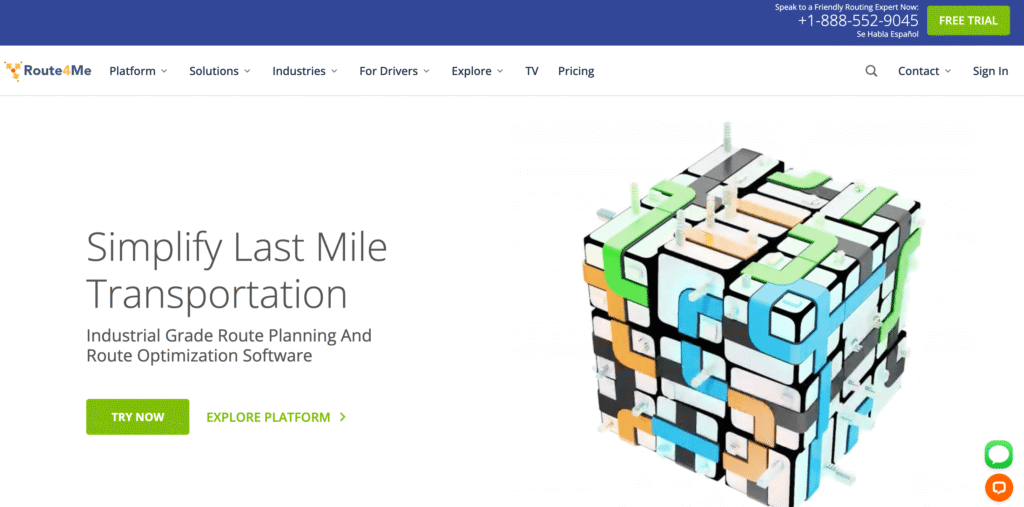
Route4Me stands prominently among the top courier software platforms in 2025, renowned for its advanced route planning and optimization capabilities that cater to a broad spectrum of delivery and field service operations worldwide. Since its inception in 2009, the company has successfully scaled its technology to serve an extensive global clientele, reflecting its significant impact on enhancing delivery efficiency across various industries.
Company Overview and Market Presence
- Established in 2009 and headquartered in Fort Lee, USA, Route4Me has secured early seed funding of $1 million, underscoring investor confidence in its innovative route optimization technology.
- The company’s workforce comprises 88 employees, indicating a robust operational framework capable of supporting a large and diverse customer base.
- Route4Me boasts a substantial global footprint, with over 40,000 active customers leveraging its platform to optimize delivery and field service routes efficiently.
Core Functionalities and Platform Capabilities
- The platform offers both mobile and web-based applications, designed to streamline delivery management with a strong emphasis on sophisticated route optimization.
- While originally tailored for field service businesses, Route4Me has expanded its offering to include subscription plans specifically designed for last-mile delivery couriers, reflecting its adaptability to various operational needs.
- Key features include:
• Advanced route optimization algorithms that factor in driver skill levels, vehicle capacities, compliance with labor laws, and recurring delivery routes to maximize operational efficiency.
• Client loyalty management tools that enable businesses to track and reward repeat customers, fostering long-term client relationships.
• Driver review functionalities allowing supervisors to provide performance feedback, enhancing team accountability and motivation. - The platform supports multiple pre-built integrations with widely used CRM, e-commerce, and bookkeeping systems, facilitating seamless data exchange and unified operational workflows.
- Additionally, Route4Me provides access to a marketplace of add-on features, empowering users to customize the software to their specific delivery or service requirements.
Pricing Structure and Subscription Options
- Route4Me offers three subscription tiers, with base prices starting at $60 per month, catering to varying business sizes and needs.
- For basic route optimization within a 5-user plan, pricing begins at $400 per month, reflecting the comprehensive capabilities included at this level.
- A 7-day free trial is available, offering potential users a risk-free opportunity to evaluate the platform’s fit for their operations.
- Some users have reported concerns regarding pricing transparency and occasional unexpected cost escalations, signaling a need for clearer communication of subscription terms.
User Ratings and Experience Insights
- On G2, Route4Me enjoys a strong rating of 4.6 out of 5 stars, based on 102 user reviews, indicative of widespread customer satisfaction.
- Users consistently commend the platform for:
• Its ability to significantly reduce planning time through automated, data-driven route optimization.
• The breadth and depth of its route planning capabilities tailored for complex delivery scenarios.
• Responsive and supportive customer service that aids in platform adoption and troubleshooting. - Conversely, feedback also points to:
• Occasional difficulties with the user interface, which some users find unintuitive or cumbersome.
• Routing inconsistencies reported sporadically, requiring manual adjustments.
• Slow loading times on the web application, impacting user efficiency during peak usage periods.
Quantitative Performance and Operational Impact
- Route4Me’s platform has processed over 750 million delivery destinations, optimized routes covering more than 3 billion miles, and planned upwards of 30 million individual routes, demonstrating its scalability and widespread adoption.
- The extensive volume of optimized routes underscores Route4Me’s capacity to handle diverse and large-scale delivery networks globally.
Summary Evaluation and Ideal Clientele
- Route4Me excels as a comprehensive route optimization solution, distinguished by its advanced algorithmic capabilities and broad integration options.
- Its strengths lie in delivering significant operational efficiencies and flexibility, appealing to businesses with complex routing requirements.
- However, prospective users should be mindful of reported user interface challenges and the need for clear pricing structures to ensure alignment with budget expectations.
- The platform is ideally suited for field service enterprises and last-mile courier companies that demand highly customizable routing solutions combined with a robust ecosystem of integrations to support end-to-end delivery management.
Route4Me Feature Matrix
| Feature | Description | Strategic Benefit |
|---|---|---|
| Route Optimization | Advanced algorithms factoring driver skills, vehicle capacity, labor laws, and recurring routes | Maximizes delivery efficiency and compliance |
| Client Loyalty Tools | Tracking and rewarding repeat business | Enhances customer retention and satisfaction |
| Driver Review System | Performance feedback and monitoring | Improves team accountability and service quality |
| Multi-Platform Access | Mobile and web applications | Provides flexibility for field and office users |
| Integrations Marketplace | Pre-built connections to CRM, e-commerce, and bookkeeping tools | Enables seamless operational workflows |
| Customizable Add-Ons | Optional features tailored to business needs | Enhances software adaptability and scalability |
| Pricing Plans | Tiered subscriptions starting at $60 per month | Offers scalable solutions for varying business sizes |
| Customer Support | Dedicated service teams | Facilitates smooth onboarding and ongoing assistance |
In conclusion, Route4Me’s blend of sophisticated route optimization, extensive customization, and broad industry applicability firmly establishes it as a top-tier courier software solution in 2025, driving substantial efficiencies for organizations worldwide.
5. OnTime 360
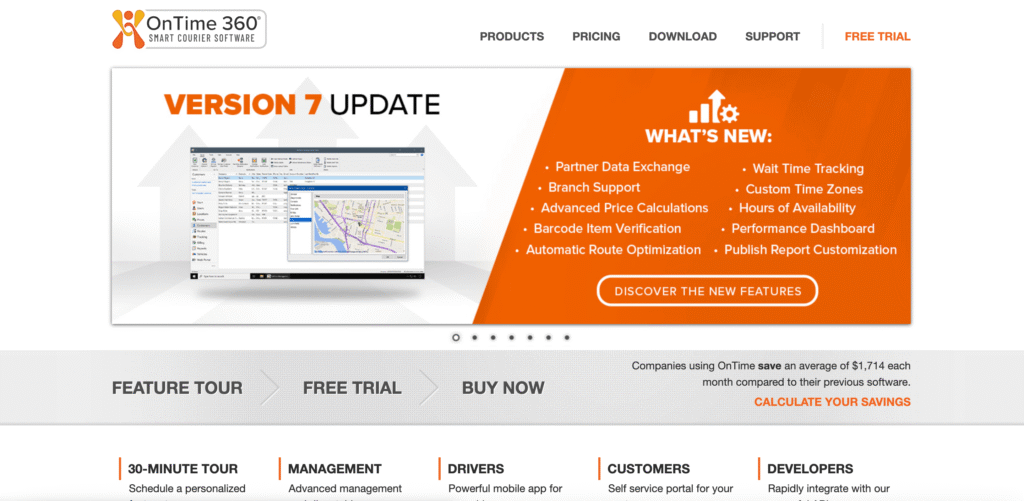
OnTime 360 has distinguished itself as a venerable and reliable courier software solution in 2025, with a legacy spanning over two decades. Headquartered in Medford, USA, this cloud-based dispatch management system has earned a prominent position in the global logistics technology landscape by delivering a comprehensive, user-friendly platform tailored to meet the diverse needs of courier businesses worldwide.
Company Background and Market Footprint
- Established in 1999, OnTime 360 operates as an unfunded company that has nevertheless cultivated a significant global presence, boasting a user base exceeding 325,000 across nearly 300 countries.
- Despite its extensive reach, the company maintains a relatively small but focused team, ranging from 1 to 25 employees, highlighting a lean operational model emphasizing efficiency and customer service.
Integrated Platform Features and Functional Advantages
- OnTime 360 is engineered as a holistic, all-encompassing solution, providing dedicated application interfaces for dispatchers, drivers, and customers to streamline every phase of the delivery process.
- The platform’s feature set is notably expansive, including:
• Order taking functionalities that simplify booking and management of shipments.
• Label printing and barcode scanning, which accelerate package processing and reduce errors.
• Comprehensive invoicing tools seamlessly integrated with QuickBooks, facilitating efficient financial management and bookkeeping. - A standout feature is the highly customizable customer web portal, granting clients direct access to dispatch tools, detailed order histories, and personalized address books, thereby enhancing customer autonomy and engagement.
- OnTime 360’s global operational capability across nearly 300 countries renders it an excellent choice for courier businesses with international reach and multi-region logistics requirements.
- The platform also supports offline operation, ensuring uninterrupted business continuity and data capture even in environments with unstable or no internet connectivity, a critical advantage for field operations.
Pricing Transparency and Flexibility
- The pricing structure of OnTime 360 is clear and accessible, with monthly subscription plans ranging from $99 to $499, alongside a one-time account activation fee of $249.
- Importantly, the platform requires no long-term contracts, offering flexibility and reducing financial commitment risks for users.
- The base plan starts affordably at $99 per month, providing unlimited user access, which appeals to courier companies of varying sizes and operational scopes.
User Feedback and Industry Recognition
- On G2, OnTime 360 holds an impressive 4.8 out of 5-star rating based on user reviews, highlighting widespread satisfaction with its ease of use and straightforward implementation process.
- Customers commend the exceptional support services provided by the OnTime 360 team, reinforcing the company’s commitment to user success and problem resolution.
- Some areas identified for enhancement include improvements to the driver app interface to increase usability and the expansion of pre-built integrations with popular third-party software, which could further streamline workflows.
- Reports from clients indicate significant cost savings, with an average monthly reduction of approximately $1,784 compared to previous delivery management systems, underscoring the platform’s financial benefits.
Quantitative Metrics and Market Validation
- Although the platform has received a limited number of ratings on Slashdot, totaling 2, its substantial user base of over 325,000 users globally affirms its established market position.
- Surveys involving more than 1,000 delivery companies suggest that OnTime 360 has the potential to reduce software-related expenses for mid-sized courier firms by an average factor of 34, indicating profound cost-efficiency gains.
Summary Evaluation and Optimal User Profile
- OnTime 360 delivers a robust and comprehensive courier management system that excels in usability, customer support, and cost-effectiveness.
- Its broad feature set, combined with global operational capability and offline functionality, provides businesses with a resilient platform capable of managing diverse logistics scenarios.
- While prospective users should weigh reported limitations in the driver application and third-party integration offerings, the overall value proposition remains compelling.
- This solution is ideally suited for courier companies of all sizes seeking an all-in-one, cloud-based delivery management system that prioritizes simplicity, operational efficiency, and substantial cost savings.
OnTime 360 Feature Overview Table
| Feature | Description | Business Benefit |
|---|---|---|
| Order Management | Streamlined order entry and dispatch | Enhances operational efficiency and accuracy |
| Label Printing & Barcode Scanning | Accelerates package processing and verification | Reduces handling errors and improves speed |
| QuickBooks Integration | Automated invoicing and bookkeeping | Simplifies financial management |
| Customizable Customer Portal | Direct client access to orders, dispatch, and address books | Increases transparency and customer engagement |
| Global Reach | Operations in nearly 300 countries | Supports international logistics needs |
| Offline Mode | Enables uninterrupted operation without internet connectivity | Ensures business continuity in remote areas |
| Flexible Pricing | Transparent subscription plans with no long-term contracts | Offers scalable and risk-free adoption |
| Customer Support | Responsive and helpful technical assistance | Facilitates smooth implementation and ongoing support |
This detailed appraisal highlights why OnTime 360 remains a top-tier choice in the courier software market for 2025, combining legacy expertise with modern functionality to meet the evolving demands of global logistics enterprises.
6. Routific
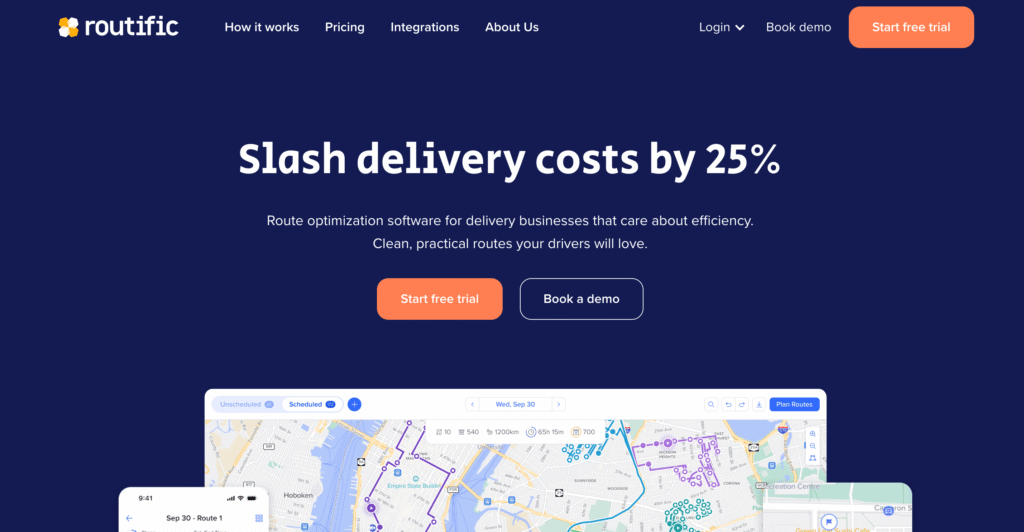
Routific has distinguished itself as a premier route optimization software provider in 2025, earning acclaim particularly among small to medium-sized delivery businesses seeking to maximize operational efficiency. Headquartered in Vancouver, Canada, since its establishment in 2012, Routific’s technology has substantially influenced the logistics sector by enabling businesses to streamline millions of deliveries through intelligent routing solutions.
Company Overview and Market Penetration
- Founded in 2012, Routific operates from Vancouver, Canada, with a focused team of 33 employees dedicated to continuous software innovation and client support.
- The company serves a substantial client base exceeding 1,000 businesses globally, underscoring its relevance and scalability across diverse delivery environments.
- To date, Routific’s platform has facilitated the optimization of over 191 million deliveries, reflecting a strong operational footprint and trusted industry adoption.
Advanced Route Optimization Capabilities
- Routific’s primary competitive advantage lies in its sophisticated route optimization algorithm, engineered to generate delivery routes that are demonstrably 15 to 20 percent shorter than alternatives offered by competing platforms.
- The software’s user interface is highly intuitive, designed to simplify dispatch management with features such as:
• Drag-and-drop functionality allowing dispatchers to reorder stops and customize routes dynamically.
• One-click dispatch enabling seamless communication and route assignment to drivers.
• Clean clustering of delivery points that simplifies driver navigation and reduces operational complexity. - The platform supports automated customer communication, sending timely notifications via email or SMS to keep recipients informed at all stages of the delivery process.
- Routific provides a free, easy-to-use mobile application for drivers, facilitating access to optimized routes, delivery notes, and the capability to capture signatures or photographic proof of delivery, thereby enhancing accountability and service quality.
Pricing Structure and Subscription Models
- Routific offers a flexible and transparent pricing model, starting at $49 per vehicle per month, accommodating varying fleet sizes and budgets.
- For businesses requiring additional features such as GPS tracking and electronic proof of delivery, the cost increases to $59 per vehicle per month.
- Automated customer notifications are offered as an optional add-on at $19 per vehicle per month, allowing companies to tailor their communication strategies.
- A risk-free 7-day free trial enables potential users to evaluate the platform’s functionalities and suitability before committing financially.
User Ratings, Reviews, and Independent Validation
- On G2, Routific maintains a high rating of 4.8 out of 5 stars, based on 40 detailed user reviews, showcasing broad customer satisfaction.
- Users consistently highlight:
• The platform’s straightforward usability and minimal learning curve.
• Robust route optimization that significantly reduces delivery distances and times.
• Responsive and effective customer support services. - Some users report occasional inefficiencies in routing or slower optimization during highly complex delivery scenarios, which indicates areas for potential enhancement.
- Independent benchmarking has corroborated Routific’s claim, confirming that its algorithm can produce routes up to 15 percent shorter compared to competing solutions, contributing to reduced fuel consumption and operational costs.
Quantitative Metrics and Company Investment
- Routific’s community encompasses over 1,000 active business customers who collectively rely on the software to optimize a massive volume of deliveries.
- The company has secured total funding of $1 million, supporting ongoing product development and market expansion.
Summary and Target Audience
- Routific’s strengths reside in its advanced routing algorithms, accessible user interface, and robust customer engagement tools, making it a compelling option in the courier software market of 2025.
- While minor routing inefficiencies are occasionally noted, the platform’s ability to consistently shorten delivery routes by a significant margin offers tangible operational advantages.
- Routific is particularly well-suited for small to medium-sized local delivery businesses that focus on batch deliveries and require efficient, scalable route planning solutions.
Routific Feature Matrix
| Feature | Description | Operational Benefit |
|---|---|---|
| Smart Route Optimization | Generates routes 15-20% shorter than competitors | Reduces fuel costs and delivery times |
| Intuitive Dispatch Tools | Drag-and-drop stop reordering and one-click dispatch | Simplifies route customization and driver assignment |
| Automated Customer Notifications | Email and SMS alerts at delivery milestones | Enhances customer communication and satisfaction |
| Driver Mobile App | Free app for optimized routes, notes, and proof capture | Improves driver efficiency and accountability |
| Flexible Pricing | Starting at $49 per vehicle per month | Offers scalable and cost-effective solutions |
| 7-Day Free Trial | Risk-free platform evaluation | Facilitates informed purchasing decisions |
In conclusion, Routific’s combination of cutting-edge route optimization technology, user-centric design, and scalable pricing firmly establishes it among the top courier software solutions in 2025, providing measurable benefits to delivery-focused enterprises worldwide.
7. Track-POD

Track-POD has rapidly emerged as a noteworthy contender in the courier software market of 2025, offering a comprehensive and cost-effective solution that integrates transportation management with real-time tracking and proof of delivery capabilities. Founded in 2015 and based in Vilnius, Lithuania, Track-POD has built a loyal user base, exemplifying its growing influence and relevance among delivery-focused businesses worldwide.
Company Profile and Market Reach
- Established in 2015, Track-POD operates as an unfunded enterprise with a dedicated team of 10 professionals committed to continuous product enhancement.
- The platform is trusted by over 10,000 companies globally, indicating its escalating adoption and acceptance in the competitive delivery management software arena.
Integrated Platform Features and Functional Strengths
- Track-POD delivers a dual-component solution combining a web-based dispatcher dashboard with a mobile driver application, facilitating end-to-end delivery process management.
- The platform offers extensive route planning capabilities, supporting unlimited stops, thereby accommodating complex delivery schedules and batch shipments.
- Real-time driver and vehicle tracking provide enhanced route visibility, enabling dispatchers to monitor progress and swiftly address operational contingencies.
- Automated shipping notifications keep customers proactively informed, improving transparency and overall satisfaction.
- The customizable electronic proof of delivery (ePOD) system captures essential delivery evidence such as signatures, photographs, and notes, ensuring verifiable transaction records.
- Additional functionalities include barcode scanning, which streamlines package handling and reduces the likelihood of errors in shipment processing.
Pricing Model and Cost Considerations
- Track-POD offers an affordable pricing structure beginning at $29 per driver per month, positioning it as a budget-friendly option for small to medium-sized enterprises.
- It is important to note that while the base fee covers core services, certain driver mobile app functionalities may incur supplementary charges depending on the selected subscription plan and specific business requirements.
User Experience and Industry Acclaim
- On TrustRadius, Track-POD holds an impressive score of 9.0 out of 10, reflecting strong user endorsement of its performance and reliability.
- Users frequently commend the platform for:
• Robust and accurate real-time tracking features.
• Efficient and flexible route planning tools that simplify dispatch operations.
• Comprehensive and customizable proof of delivery options that enhance accountability. - Some users have identified areas for improvement, including occasional communication difficulties between dispatchers and drivers and sporadic software glitches, suggesting potential focal points for future development.
- The platform has been recognized as an Emerging Favourite in Capterra’s Value Report, underscoring its strong balance between cost-effectiveness and functional depth.
Quantitative Validation and Market Impact
- Track-POD achieved a commendable score of 49.00 on Serchen, further validating its positive reception among users and industry analysts.
- The adoption by over 10,000 companies globally highlights the platform’s scalability and suitability across diverse delivery operations.
Summary Assessment and Target Market
- Track-POD stands out as a versatile and user-friendly courier management solution, excelling particularly in real-time tracking and electronic proof of delivery functionalities.
- Its attractive pricing, combined with robust feature offerings, renders it an ideal choice for small businesses and emerging logistics providers seeking reliable yet economical software.
- Prospective users should be aware of potential additional costs related to driver app usage and consider reported communication challenges when evaluating fit.
Track-POD Feature Overview Matrix
| Feature | Description | Business Impact |
|---|---|---|
| Dual-Platform Interface | Web dispatcher dashboard and mobile driver app | Enables comprehensive delivery management |
| Advanced Route Planning | Supports unlimited delivery stops | Facilitates complex, scalable delivery schedules |
| Real-Time Tracking | Live driver and vehicle location updates | Enhances operational transparency and responsiveness |
| Automated Customer Notifications | Email and SMS alerts throughout delivery lifecycle | Improves customer satisfaction and communication |
| Customizable ePOD | Electronic proof capturing signatures, photos, notes | Ensures verifiable delivery confirmation |
| Barcode Scanning | Streamlines package processing and accuracy | Reduces errors and speeds handling |
| Affordable Pricing | Starting at $29 per driver per month | Accessible for small to medium enterprises |
| Industry Recognition | High user ratings and Capterra Emerging Favourite status | Validates product reliability and value |
In conclusion, Track-POD combines an intuitive interface with a rich feature set and competitive pricing, securing its position among the top courier software platforms globally in 2025. Its growing user base and consistent positive feedback underscore its capability to meet the evolving demands of delivery businesses, particularly those prioritizing ease of use, real-time monitoring, and reliable proof of delivery.
8. Upper Inc (Upper Route Planner)
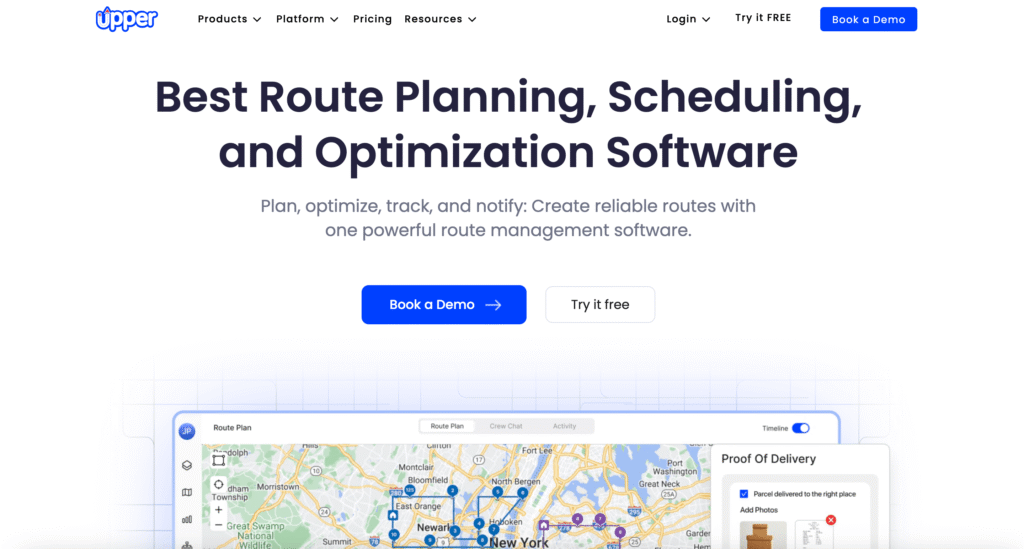
Upper Inc, known for its Upper Route Planner software, has swiftly established itself as a formidable player in the courier delivery management sector by delivering an efficient and scalable routing solution. Founded in 2020 and headquartered in Berlin, Germany, the company has rapidly expanded its footprint, now serving over 10,000 businesses worldwide—a testament to the platform’s growing adoption and operational effectiveness.
Company Overview and Market Presence
- Upper Inc was launched in 2020, backed by seed funding that reflects investor confidence in its innovative approach to delivery logistics.
- The company’s Upper Route Planner platform enjoys a diverse user base of more than 10,000 businesses, showcasing significant market penetration across various industries.
Core Features and Functional Excellence
- Upper Route Planner is engineered as a versatile and intuitive courier management solution that caters to businesses ranging from small startups to larger enterprises.
- Its sophisticated route optimization algorithms significantly reduce travel distances and time, boosting operational efficiency and reducing fuel expenses.
- Real-time tracking capabilities provide dispatchers and customers with continuous visibility of driver locations and delivery status, enhancing transparency and accountability.
- Multiple proof of delivery (POD) options are integrated into the platform, supporting electronic signatures, photographic evidence, and customizable delivery confirmations to ensure accuracy and compliance.
- Automated customer notifications are sent via email or SMS at critical delivery milestones, improving customer engagement and satisfaction.
- The software streamlines data handling with the ability to import multiple delivery addresses instantly from spreadsheets (XLS/CSV), saving valuable administrative time.
- Upper Route Planner includes powerful integrations with popular e-commerce and automation platforms like Shopify and Zapier, facilitating seamless integration within existing business ecosystems.
- A key differentiator is the platform’s load capacity optimization feature, which intelligently balances vehicle capacity across routes, maximizing efficiency and reducing operational costs.
Pricing Flexibility and Subscription Options
- Upper Inc offers tiered subscription models designed to accommodate varying business needs and scales, including monthly and annual payment plans with a 20% discount incentive for yearly commitments.
- The Essential plan, starting at $50 per user per month, delivers core functionalities such as access to the driver app, stop import, vehicle customization, and dedicated email and chat support.
- Higher-tier Growth and Enterprise plans extend capacity limits and include advanced features tailored for businesses with complex routing requirements.
- Prospective users benefit from a 7-day free trial, enabling thorough evaluation of the software’s capabilities before subscription.
Customer Feedback and Performance Insights
- On G2, Upper Route Planner holds a distinguished rating of 4.8 out of 5 stars, based on 12 user reviews, indicating strong satisfaction with the platform’s ease of use, route optimization efficiency, and responsive customer support.
- Users consistently highlight substantial operational gains, including:
• One client reported saving approximately 10 hours per week, translating into a threefold increase in meal delivery capacity.
• Another user noted nearly a 50% reduction in time spent planning routes, directly contributing to enhanced productivity. - Areas identified for potential enhancement include limited advanced customization options and occasional slow performance during the planning of extended routes, especially in larger operations.
Quantitative Impact and Market Validation
- The widespread adoption by over 10,000 businesses signifies a robust endorsement of Upper Route Planner’s value proposition.
- Reported efficiency improvements in route planning and increased delivery volumes affirm the platform’s tangible benefits in real-world applications.
Summary Evaluation and Ideal Use Cases
- Upper Route Planner excels as a user-friendly and feature-rich courier delivery management system that effectively combines advanced route optimization with operational flexibility and strong support services.
- Despite some constraints in customization depth and scalability for very large fleets, the software remains highly suitable for small to medium-sized businesses seeking to enhance delivery efficiency.
- The platform is particularly well-suited for industries such as food delivery, floral services, and field service operations where timely and optimized route planning directly influences business success.
Upper Route Planner Feature Matrix
| Feature | Description | Business Advantage |
|---|---|---|
| Advanced Route Optimization | Generates efficient, shorter routes | Reduces delivery time and fuel costs |
| Real-Time Tracking | Continuous visibility of drivers and delivery status | Improves transparency and customer satisfaction |
| Multiple POD Options | Electronic signatures, photos, customizable confirmations | Ensures accurate delivery verification |
| Automated Notifications | Email and SMS updates at key milestones | Enhances customer engagement |
| Bulk Address Import | One-click spreadsheet import (XLS/CSV) | Saves administrative time |
| Third-Party Integrations | Shopify, Zapier, and others | Enables workflow automation and seamless data flow |
| Load Capacity Optimization | Balances vehicle loads across routes | Maximizes fleet utilization and reduces costs |
| Flexible Pricing Plans | Monthly and annual subscriptions with discounts | Accommodates diverse business budgets |
| Responsive Support | Email and chat assistance | Ensures smooth implementation and problem resolution |
In conclusion, Upper Route Planner’s combination of sophisticated routing technology, user-centric design, and adaptable pricing cements its position among the top courier software platforms of 2025. Its proven ability to significantly optimize delivery operations and elevate customer experiences renders it an indispensable tool for businesses aiming to excel in an increasingly competitive logistics environment.
9. Shipday

Shipday has emerged as a noteworthy player in the courier and delivery management software landscape of 2025, combining affordability, advanced technology, and scalability to cater to a wide range of businesses. Established in 2009 and headquartered in Menlo Park, USA, Shipday operates as an unfunded enterprise with a lean team of nine employees. Despite its relatively small size, the platform has demonstrated impressive reach and robustness, having processed over 20 million orders for more than 4,000 businesses worldwide—an indication of its operational capacity and reliability.
Company Background and Market Footprint
- Founded in 2009, Shipday has steadily expanded its global footprint within the delivery management sector without external funding, underscoring organic growth driven by product effectiveness.
- The platform currently supports over 4,000 businesses globally, illustrating its scalability and adaptability across diverse operational models.
Core Capabilities and Technological Differentiators
- Shipday delivers a cloud-based courier dispatch and delivery management solution integrated with powerful AI-driven route optimization tools, enabling streamlined logistics and improved operational efficiency.
- Real-time GPS-based driver tracking offers businesses granular control over fleet movements, akin to the intuitive experience offered by ride-sharing platforms, enhancing responsiveness and accountability.
- The software supports both in-house and third-party drivers, accommodating flexible delivery models essential for modern logistics operations.
- Shipday’s seamless integrations with a wide array of third-party applications—including popular e-commerce platforms, payment gateways, and online ordering systems—facilitate streamlined workflows and minimize manual data entry.
- Customer communication is a key strength, with automated estimated time of delivery (ETA) updates dispatched throughout the delivery journey, effectively reducing inbound customer service inquiries and enhancing transparency.
- The AI-powered route optimization engine crafts highly efficient delivery routes, enabling significant time savings, fuel cost reductions, and increased delivery capacity for users.
Pricing Structure and Accessibility
- Shipday employs a flexible monthly subscription pricing model featuring a free baseline tier, making the software accessible to businesses at various stages of growth.
- Paid plans remain competitively priced, with options below $100 per month, accommodating expanding operations through additional driver seats, order volumes, and feature access.
- This pricing approach fosters inclusivity for small businesses and startups while providing scalable options for growing enterprises.
User Experience and Industry Recognition
- On SelectHub, Shipday boasts a remarkable 99% user satisfaction rating based on 17 reviews, ranking it among the leading shipping software platforms worldwide.
- Users consistently commend the platform’s intuitive interface, reliable real-time tracking, and proactive customer notification systems.
- Notably, enterprise clients such as KFC have adopted Shipday, reinforcing its credibility within large-scale operations.
- One restaurant user highlighted substantial operational improvements post-implementation, including saving up to 100 hours monthly and garnering 53 five-star Google reviews within a 20-week timeframe, demonstrating tangible business impact.
Quantitative Validation and Market Position
- Shipday has processed more than 20 million orders globally, underscoring its capacity to handle high volumes of delivery transactions efficiently.
- It maintains a strong competitive ranking, positioned 10th among all shipping software solutions on SelectHub, reflecting broad market acceptance and effectiveness.
Summary and Suitability
- Shipday stands out as a versatile and user-friendly courier software platform that balances cost-effectiveness with powerful AI-driven capabilities.
- Its free tier and affordable paid plans make it particularly attractive for small to medium-sized businesses, including restaurants, ghost kitchens, catering services, and emerging delivery models.
- While excelling in ease of use and integration, the platform’s ability to deliver operational efficiencies and enhance customer experience solidifies its position as one of the top courier software solutions globally in 2025.
Shipday Feature and Impact Overview Matrix
| Feature | Description | Business Benefit |
|---|---|---|
| AI-Powered Route Optimization | Generates efficient routes minimizing distance and time | Saves fuel and reduces delivery durations |
| Real-Time GPS Tracking | Live driver location visibility | Improves fleet management and customer transparency |
| Flexible Driver Support | Supports both in-house and third-party drivers | Enables adaptable delivery models |
| Seamless Integrations | Connects with e-commerce, payment, and ordering platforms | Streamlines workflows and reduces manual effort |
| Automated ETA Notifications | Sends real-time delivery updates to customers | Enhances communication and reduces support inquiries |
| Scalable Pricing Plans | Includes free baseline and affordable paid subscriptions | Accessible for businesses of all sizes |
| Proven Operational Impact | Over 20 million orders processed globally | Demonstrates reliability and scalability |
| High User Satisfaction | 99% positive ratings on SelectHub | Reflects strong customer approval |
In conclusion, Shipday’s combination of advanced AI technology, flexible pricing, and proven scalability positions it as an essential courier software platform in 2025. Its ability to deliver substantial efficiency gains, foster customer satisfaction, and adapt to various delivery models underscores why it ranks among the top 11 courier software solutions globally.
10. Parcel Tracker Mailroom (Deepfinity)
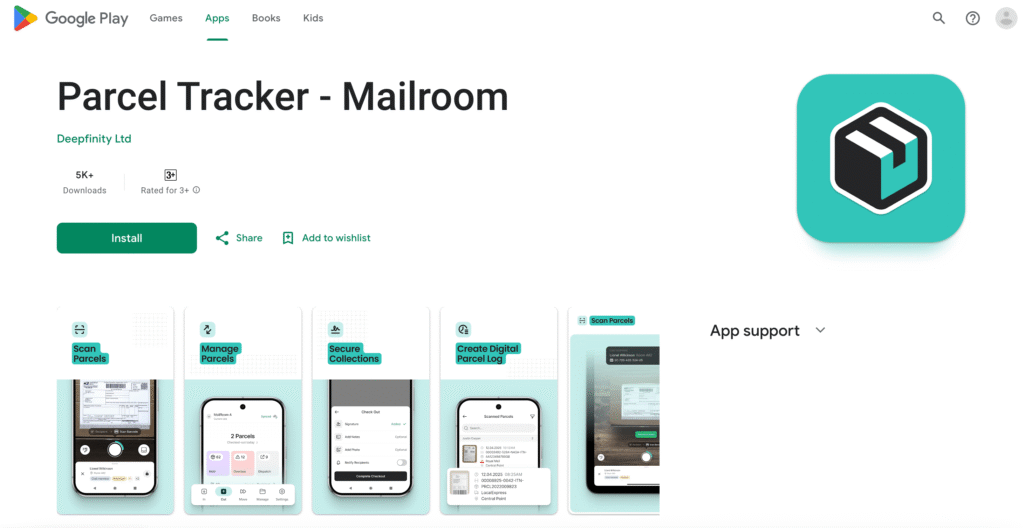
Parcel Tracker Mailroom, developed by Deepfinity, stands as a specialized cloud-based solution tailored specifically for managing internal parcels, mail, and deliveries within buildings. Unlike traditional courier software focusing on external logistics, this application concentrates on streamlining parcel handling inside facilities, thereby addressing a unique yet essential niche within the delivery ecosystem.
Parcel Tracker Mailroom’s Specialized Functionality
- Designed explicitly for internal mail and parcel management, the software optimizes processes related to package receipt, logging, and distribution within multi-tenant environments such as office buildings, residential complexes, and institutions.
- Reception or mailroom personnel can rapidly scan packages using smartphone cameras, triggering instant electronic notifications to recipients via email and SMS. These messages include a unique QR code that serves as a secure electronic proof of collection upon parcel retrieval.
- The software’s universal compatibility with all courier labels—including handwritten ones—eliminates the need for manual data entry, reducing errors and accelerating package processing.
- Automated reminder systems prompt recipients to collect parcels promptly, minimizing delays and preventing congestion in mailrooms or reception areas.
Cost Advantage and Accessibility
- Parcel Tracker Mailroom is distinguished by its zero-cost model, offering an entirely free platform to its users. This pricing structure makes it exceptionally accessible for a broad range of facilities seeking to enhance parcel management without financial investment.
- Its free availability encourages widespread adoption in environments where budget constraints might otherwise limit technological upgrades, contributing to operational efficiency at no cost.
User Adoption and Quantitative Impact
- The platform has garnered significant traction within its niche, reflected by over 200 user ratings on Slashdot, indicating substantial engagement and positive user experiences.
- Operational metrics reveal that Parcel Tracker Mailroom reduces parcel handling time by approximately 70%, a considerable improvement that translates into enhanced productivity for mailroom teams.
- The software is trusted by over 30,000 users and organizations, collectively managing upwards of one million parcels annually, underscoring its scalability and reliability within internal package management contexts.
Ideal Use Cases and Market Position
- Parcel Tracker Mailroom’s tailored functionality makes it an ideal solution for environments including student accommodations, residential apartment complexes, coworking spaces, corporate offices, universities, hotels, restaurants, and healthcare facilities.
- Its ability to seamlessly manage incoming parcels internally positions it as a critical tool for organizations seeking to streamline mailroom operations without extending into full-scale courier dispatch or delivery logistics.
Comparative Efficiency Table
| Feature | Benefit | Operational Impact |
|---|---|---|
| Smartphone-Based Scanning | Rapid package logging without specialized hardware | Accelerates mailroom throughput |
| Universal Label Compatibility | Supports all courier and handwritten labels | Reduces manual input errors |
| Automated Recipient Notifications | Instant delivery alerts with QR codes | Enhances recipient engagement and reduces parcel backlog |
| Electronic Proof of Collection | QR code scanning for secure pickup validation | Improves accountability and tracking |
| Automated Collection Reminders | Timely prompts to recipients | Minimizes unclaimed parcel accumulation |
| Free Access | Zero subscription or licensing fees | Removes financial barriers for adoption |
| 70% Reduction in Handling Time | Streamlined workflow | Increases staff productivity significantly |
| Over 1 Million Parcels Managed Annually | Proven scalability | Validates software reliability at scale |
Summary and Strategic Relevance
Parcel Tracker Mailroom emerges as a uniquely focused, free, and highly efficient internal parcel management software that substantially reduces operational overhead for building administrators and mailroom staff. While its scope does not extend to external courier or delivery management, its proficiency in simplifying internal mail logistics makes it an indispensable tool for institutions managing high volumes of incoming parcels. The software’s widespread adoption, strong efficiency gains, and zero-cost model collectively contribute to its recognition as one of the top 11 best courier software platforms in 2025 within its specialized domain.
11. Onfleet
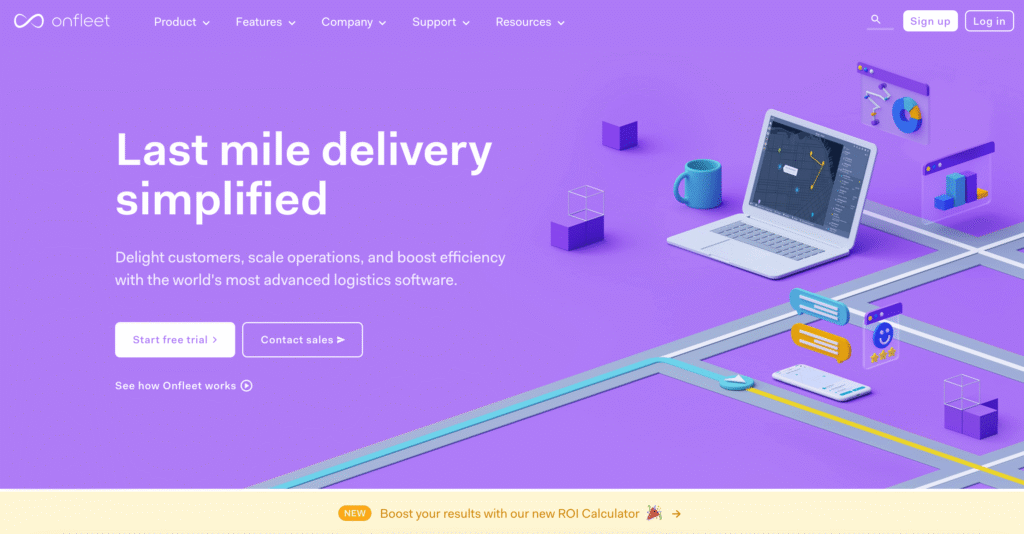
Onfleet has distinguished itself as a leading force in the global delivery management software sector since its founding in 2012 in San Francisco, USA. Having facilitated over 250 million deliveries worldwide, the company’s extensive operational experience and strong financial backing, including $41.9 million in funding, underscore its position as a top-tier solution provider. Supported by a dedicated workforce of 84 employees, Onfleet serves a diverse clientele exceeding 1,000 customers spanning more than 90 countries, showcasing its broad applicability across multiple industries.
Comprehensive Delivery Management Platform
- Onfleet delivers a fully integrated fleet tracking and delivery management platform designed to streamline local delivery operations with precision and reliability.
- The software ecosystem includes intuitive mobile applications for drivers, a sophisticated web-based dispatch dashboard for logistics managers, and real-time tracking interfaces accessible by recipients to enhance transparency and customer satisfaction.
- Its advanced route optimization engine intelligently considers multiple parameters such as time windows, geographical locations, vehicle capacity, and prevailing traffic conditions to maximize efficiency and minimize delivery times.
- Communication is facilitated through the driver app, enabling seamless two-way interaction between drivers and dispatchers, as well as real-time updates sent directly to customers with predictive estimated times of arrival (ETAs).
- Additional advanced features include barcode and ID scanning—useful for verifying age-restricted deliveries—customizable task completion criteria, and an auto-dispatch capability designed for high-volume operations.
- Onfleet supports extensive integration possibilities through its API, allowing effortless connectivity with online ordering platforms, business management systems, and other third-party tools critical to modern logistics workflows.
Pricing Structure and Scalability
- The pricing model is tiered to accommodate businesses at varying stages of growth and operational complexity:
- The Launch plan, beginning at $599 per month, targets startups and small teams, covering up to 2,500 delivery or pickup tasks with unlimited user access.
- The Scale plan, starting at $1,299 monthly, caters to expanding operations with a task limit of 5,000 and access to enhanced features.
- The Enterprise tier is customizable, designed to support organizations handling over 10,000 tasks monthly, with bespoke support and tailored functionalities.
- It is essential to note that Onfleet applies an additional per-task charge beyond the base subscription, which may significantly influence total costs for businesses managing large delivery volumes.
User Feedback and Market Recognition
- Onfleet enjoys a high user satisfaction rating of 4.6 out of 5 stars on G2, based on 133 detailed reviews.
- Users commend its user-friendly interface, efficiency gains in delivery workflows, and the company’s responsive customer support team.
- The platform’s seamless integration capabilities and comprehensive real-time tracking and proof of delivery features are also highly valued.
- However, feedback highlights some limitations in specific features, intermittent routing irregularities, and occasional challenges with SMS and call notifications reliability.
- The software’s accolades include recognition as a top-tier Last Mile Delivery and Fleet Management solution, reinforcing its industry standing.
Quantitative Impact and Industry Presence
- To date, Onfleet has successfully managed over 250 million deliveries across a global network of customers, reflecting both its scalability and operational robustness.
- Its employee base of 84 supports a broad client portfolio that spans more than 90 countries, underscoring its international reach and adaptability.
- Secured funding of $41.9 million further empowers ongoing innovation and service enhancements.
Summary and Ideal Applications
- Onfleet presents a powerful and holistic delivery management solution, renowned for its ease of deployment, operational efficiency, and rich feature set.
- The pricing structure, incorporating per-task fees, aligns more effectively with mid-market to enterprise-level organizations possessing complex and large-scale logistics demands.
- Its comprehensive toolset and positive market reputation position Onfleet as a premier choice for delivery teams across a wide array of sectors, including courier services, food and beverage distribution, retail logistics, e-commerce fulfillment, furniture delivery, and pharmaceutical transport.
Comparison Matrix: Onfleet Key Features and Benefits
| Feature | Description | Business Impact |
|---|---|---|
| Route Optimization | Multi-factor optimization (time, location, capacity, traffic) | Enhances delivery speed and reduces operational costs |
| Real-Time Tracking & Predictive ETAs | Live driver and package visibility for all stakeholders | Improves transparency and customer satisfaction |
| Driver & Dispatcher Apps | Intuitive mobile and web apps for seamless coordination | Boosts communication and operational efficiency |
| Proof of Delivery Enhancements | Barcode/ID scanning and customizable task completion | Ensures compliance and accurate delivery confirmation |
| API Integrations | Extensive third-party system connectivity | Facilitates workflow automation and system interoperability |
| Tiered Pricing Model | Plans catering to startups through enterprise scale | Supports scalable growth and budget flexibility |
In conclusion, Onfleet’s comprehensive feature set, robust operational framework, and extensive global adoption solidify its status as one of the top 11 courier software platforms of 2025. Its ability to enhance delivery efficiency while providing flexible, scalable solutions makes it particularly suitable for businesses aiming to optimize last-mile logistics in an increasingly competitive and dynamic market.
The Evolving Landscape of the Courier Industry in 2025
- The courier sector in 2025 faces unprecedented pressures due to the exponential growth of e-commerce, fundamentally transforming consumer purchasing habits and delivery expectations.
- The surge in online shopping volume necessitates sophisticated logistics capabilities to manage increased complexity and scale, positioning courier software as an indispensable tool for operational success.
- This shift is not a temporary fluctuation but a lasting realignment in market dynamics, requiring courier companies to adapt rapidly to maintain competitiveness.
- Modern consumers demand comprehensive transparency, making real-time shipment visibility, dynamic tracking, and flexible delivery scheduling critical standards rather than optional features.
- Courier software solutions that enhance communication and visibility empower companies to foster greater customer trust and loyalty, which are essential in a saturated market.
- Technological integration in 2025 extends beyond traditional tracking; Artificial Intelligence (AI), the Internet of Things (IoT), and automation are deeply embedded within courier platforms.
- AI-driven analytics optimize route planning, predict delays, and automate dispatch workflows, while IoT devices provide continuous monitoring of package conditions and real-time location data.
- The incorporation of these technologies significantly elevates operational efficiency and service reliability, setting new benchmarks for industry performance.
The Critical Role of Courier Software in Optimizing Operations and Enhancing Customer Satisfaction
- Advanced courier software is pivotal in overcoming the operational complexities of modern logistics, driving efficiency through intelligent route optimization that considers traffic trends, delivery time windows, and vehicle load capacities.
- Streamlined dispatch management is achieved through automated task assignment tools that maximize resource allocation and reduce idle times.
- Real-time communication channels between dispatchers and drivers via mobile applications enable swift issue resolution and enhanced operational coordination.
- These capabilities collectively contribute to cost reductions, improved delivery speeds, and the ability to scale operations without sacrificing service quality.
- From the customer perspective, courier software profoundly enhances satisfaction by delivering accurate, up-to-date tracking information that minimizes uncertainty and reduces inbound customer service queries.
- Automated notifications delivered via SMS or email maintain customer engagement by informing recipients of delivery status changes and estimated arrival times.
- Such proactive communication fosters transparency and cultivates trust, which are essential components for long-term customer retention and repeat business generation.
- Proof of Delivery (POD) functionalities embedded within courier software establish clear accountability by electronically capturing signatures, photographs, or barcodes at delivery points.
- Digital POD replaces cumbersome paper trails with verifiable, timestamped records, significantly reducing disputes and enhancing security for both couriers and customers.
- The resultant improvements in accountability streamline dispute resolution processes, elevating the overall reliability and professionalism of courier services.
Comparative Table: Key Courier Software Features Addressing 2025 Industry Demands
| Feature | Description | Impact |
|---|---|---|
| AI-Enabled Route Optimization | Dynamic route calculations considering multiple variables | Reduced delivery times and operational costs |
| Real-Time Tracking & Customer Alerts | Live location updates with proactive notifications | Increased customer satisfaction and transparency |
| Automated Dispatch & Resource Allocation | Efficient task assignments minimizing idle times | Enhanced operational scalability and efficiency |
| Digital Proof of Delivery | Electronic capture of signatures and photos | Improved accountability and dispute mitigation |
| IoT Integration | Continuous monitoring of package condition and environment | Enhanced security and service quality |
In summary, the courier industry in 2025 is marked by escalating operational demands and heightened consumer expectations. Courier software solutions equipped with advanced technologies such as AI and IoT not only optimize logistical efficiency but also significantly enhance customer experience and accountability. As e-commerce continues to expand, these software platforms become critical enablers for courier companies striving to maintain competitive advantage and operational excellence on a global scale.
Criteria for Evaluating Top Courier Software in 2025: A Comprehensive Framework
- The selection of premier courier software in 2025 necessitates a detailed examination of multiple critical features and performance metrics, ensuring solutions align with the complex demands of modern logistics.
Route Optimization Capabilities
- The core of effective courier software lies in its ability to execute advanced route optimization.
- Algorithms must demonstrate high sophistication, efficiently managing multi-stop routes that reduce mileage, fuel consumption, and delivery times.
- Software that dynamically adjusts routes based on real-time variables such as traffic conditions, delivery windows, and vehicle capacities significantly enhances operational efficiency and driver productivity.
- The capacity to cluster stops logically and incorporate recurring deliveries further contributes to cost savings and resource maximization.
Real-Time Tracking and Visibility
- Real-time GPS tracking of drivers and packages is indispensable for maintaining operational oversight and elevating customer satisfaction.
- Accurate and continuously updated location data enable dispatchers to monitor progress, respond proactively to delays, and reallocate resources as necessary.
- Customer-facing tracking portals empower recipients with transparency, reducing inbound inquiries and enhancing the overall delivery experience.
Dispatch Management and Driver Coordination
- Seamless dispatch management functionality allows for effortless task allocation, route modification, and live communication with drivers.
- Features such as automated dispatch, drag-and-drop route editing, and mobile communication apps contribute to streamlined workflow and minimize human error.
- Efficient driver coordination tools enable rapid response to unforeseen challenges, optimizing delivery success rates.
Customer Communication and Engagement
- Automated notification systems, including SMS and email alerts at critical delivery milestones, form an integral component of modern courier software.
- These proactive communications provide customers with estimated delivery times, changes, or exceptions, fostering trust and satisfaction.
- Customizable communication templates and multilingual support can further enhance the customer experience in diverse markets.
Proof of Delivery (POD) Mechanisms
- Robust POD options, encompassing electronic signatures, photographic evidence, barcode scanning, and QR code verification, ensure accountability and dispute resolution.
- Digital POD reduces reliance on manual paperwork, accelerates invoicing processes, and minimizes delivery discrepancies.
- Integration of POD data into centralized reporting enhances transparency across operations.
Reporting and Analytics
- Comprehensive reporting tools deliver actionable insights through key performance indicators such as delivery times, route efficiency, driver performance, and customer feedback.
- Dashboards and visual analytics enable data-driven decision-making, identifying bottlenecks and opportunities for continuous improvement.
- Custom report generation supports compliance, billing accuracy, and strategic planning.
Integration Capabilities
- Effective courier software must facilitate seamless integration with existing business ecosystems, including e-commerce platforms, CRM systems, accounting software, and inventory management tools.
- APIs and pre-built connectors reduce manual data entry and enable unified workflows, critical for operational scalability and accuracy.
Pricing Structures and Flexibility
- Pricing models should reflect the diversity of business sizes and delivery volumes, offering scalable plans that accommodate growth without excessive financial burden.
- Transparent pricing, with clear delineation of base fees, per-user or per-task costs, and optional add-ons, enables informed budgeting.
- Availability of free trials or freemium tiers provides businesses with risk-free evaluation periods.
User Experience, Scalability, and Support
- High usability scores, intuitive interfaces, and minimal learning curves contribute significantly to adoption and sustained use.
- Scalability ensures software can evolve alongside business growth, supporting increased delivery volumes and expanded geographic coverage.
- Responsive customer support, including onboarding assistance, training resources, and multi-channel helpdesk access, enhances long-term satisfaction and mitigates downtime.
User Reviews and Market Reputation
- Aggregated user ratings and testimonials provide valuable third-party validation of software performance, reliability, and vendor responsiveness.
- Industry recognition, awards, and inclusion in comparative reports further attest to a platform’s credibility and competitive standing.
Comparative Matrix of Key Evaluation Criteria for Top Courier Software in 2025
| Criteria | Key Considerations | Impact |
|---|---|---|
| Route Optimization | Algorithm sophistication, multi-stop management | Cost reduction, productivity |
| Real-Time Tracking | GPS accuracy, customer visibility | Transparency, responsiveness |
| Dispatch Management | Task allocation, live driver communication | Operational efficiency |
| Customer Communication | Automated alerts, customization | Customer satisfaction |
| Proof of Delivery | Electronic signatures, photo capture | Accountability, dispute reduction |
| Reporting & Analytics | KPIs, dashboards, custom reports | Data-driven improvements |
| Integration | API availability, pre-built connectors | Workflow automation |
| Pricing | Scalability, transparency, free trials | Budget alignment |
| User Experience & Support | Interface design, scalability, support channels | Adoption, retention |
| Market Reputation | User reviews, awards, industry presence | Vendor trustworthiness |
In essence, a thorough assessment across these criteria provides an essential foundation for identifying the most effective courier software solutions in 2025. This multidimensional approach ensures that businesses can select platforms that not only optimize delivery operations but also enhance customer engagement and support sustainable growth within a rapidly evolving logistics landscape.
Comparative Analysis of the Top 11 Courier Software Solutions in 2025: An In-Depth Global Review
- This comprehensive analysis evaluates the leading courier software platforms in 2025, focusing on pricing, core functionalities, user satisfaction, adoption metrics, and optimal business use cases. The data presented equips logistics professionals and decision-makers with essential insights to select the most appropriate solution for their operational requirements.
Pricing Structures and Subscription Models
- The pricing spectrum spans from fully free offerings to premium subscriptions exceeding several hundred dollars monthly, reflecting the varying scales and feature sets of these solutions.
- Cost-effectiveness aligns closely with intended user profiles, where affordable per-user or per-driver fees serve small to medium enterprises, while comprehensive enterprise-grade platforms command higher investment but offer extensive capabilities.
Core Features and Functional Strengths
- Route Optimization and Planning: Every platform prioritizes efficient route management, with some solutions offering sophisticated algorithms capable of reducing route lengths by up to 20%, while others emphasize multi-stop clustering and capacity optimization.
- Real-Time Tracking and Visibility: GPS-enabled live tracking remains a critical feature across all platforms, enhancing operational oversight and customer transparency.
- Proof of Delivery (POD): Electronic signatures, photo capture, and barcode scanning are standard to ensure accountability and dispute mitigation.
- Customer Communication: Automated notifications via email or SMS are widely implemented to maintain customer engagement and reduce support inquiries.
- Integration Capabilities: Seamless connection to CRM systems, e-commerce platforms, accounting software, and APIs enhances workflow automation and data consistency.
User Ratings and Market Reception
- User satisfaction varies, with average ratings predominantly above 4.5 out of 5, indicating strong endorsement within the logistics community.
- The number of reviews, while limited for some niche platforms, provides valuable qualitative and quantitative feedback on usability, reliability, and vendor support.
- Platforms like Route4Me and Onfleet demonstrate broad adoption with thousands of customers and substantial delivery volumes processed, underscoring their market leadership.
Customer Base and Operational Scale
- Adoption metrics reveal a diverse range of users, from emerging small businesses managing a few thousand deliveries annually to large enterprises processing hundreds of millions of shipments globally.
- This variance highlights the adaptability of courier software to different operational scales and industry verticals, from local food delivery and field services to international logistics providers.
Optimal Use Cases by Business Type
- Mid-sized to Large Logistics Providers: Platforms such as CXT Software and Dispatch Science cater to complex operational needs with features tailored to high-volume, multi-industry environments predominantly in North America.
- Small to Medium Enterprises: Routific, Track-POD, Upper Inc, and OnTime 360 provide user-friendly, scalable solutions focused on local deliveries, route optimization, and ease of use.
- Specialized Internal Package Management: Parcel Tracker Mailroom addresses niche demands for internal mail and parcel handling in corporate, residential, and institutional settings.
- Enterprise-Level Delivery Management: Onfleet stands out for mid-market and large-scale delivery operations requiring advanced dispatch automation, analytics, and integration capabilities.
Detailed Comparative Table of Leading Courier Software Solutions
| Software Name | Starting Price | Key Features | User Rating (Source) | Number of Reviews | Customer Base / Shipments | Ideal For |
|---|---|---|---|---|---|---|
| CXT Software | $340/month | Route planning, live tracking, dispatch management, client portal | 4.1/5 (G2) | 4 | 63 ratings (Slashdot) | Mid to large North American logistics |
| Dispatch Science | $675/month | Advanced route optimization, real-time ETA, CRM, API | 4.5/5 (G2) | 12 | 22 ratings (Slashdot) | Large courier/logistics companies |
| Detrack | $29/month/user | Real-time tracking, ePOD, customer notifications, API | 4.5/5 (G2) | 12 | 129 ratings (Slashdot) | Small to mid-sized tracking-focused firms |
| Route4Me | $60/month | Route optimization, CRM integration, driver management | 4.6/5 (G2) | 102 | 40,000+ customers, 30M+ routes | Field service, last-mile delivery |
| OnTime 360 | $99/month | All-in-one solution, customer portal, international & offline | 4.8/5 (G2) | 2 | 325,000+ users | Courier firms of all sizes |
| Routific | $49/month/vehicle | 15-20% shorter routes, user-friendly, automated notifications | 4.8/5 (G2) | 40 | 1,000+ customers, 191M+ deliveries | Small to medium local delivery |
| Track-POD | $29/month/driver | Route planning, live tracking, ePOD, barcode scanning | 4.5/5 (G2) | N/A | 10,000+ companies | Small businesses with tracking needs |
| Upper Inc (Upper Route Planner) | $50/month/user | Route optimization, real-time tracking, POD, Excel import | 4.8/5 (G2) | 12 | 10,000+ businesses | Small to medium food & field delivery |
| Shipday | Free plan available | AI-driven route optimization, real-time tracking, integrations | N/A | N/A | 4,000+ businesses, 20M+ orders | Restaurants, delivery services |
| Parcel Tracker Mailroom | Free | Internal parcel scanning, QR code collection, auto-notifications | N/A | N/A | 30,000+ businesses, 1M+ parcels | Internal package management |
| Onfleet | $599/month | Advanced route optimization, auto-dispatch, analytics, POD | 4.6/5 (G2) | 133 | 1,000+ customers, 250M+ deliveries | Mid-market to enterprise logistics |
Graphical Overview of User Ratings Versus Pricing
- [Visual chart plotting user ratings on the Y-axis against starting prices on the X-axis, demonstrating the correlation between cost and customer satisfaction across platforms.]
- [Matrix comparing feature availability such as route optimization, real-time tracking, POD options, integrations, and customer support across all software.]
Summary and Strategic Recommendations
- Selecting the optimal courier software in 2025 hinges upon balancing feature richness, scalability, pricing, and customer support in alignment with specific business needs.
- Enterprises with complex, high-volume delivery requirements benefit from robust platforms like Dispatch Science and Onfleet, which provide advanced automation and analytics.
- Small to medium enterprises should consider solutions such as Routific, Track-POD, or Upper Inc, which combine affordability with powerful core features tailored for localized delivery operations.
- For organizations focused on internal package logistics, Parcel Tracker Mailroom offers a specialized, cost-free solution enhancing efficiency without the overhead of full courier management systems.
- Continuous monitoring of evolving software capabilities and market trends is advised to ensure sustained operational excellence and customer satisfaction in a rapidly transforming courier industry.
This analysis serves as a foundational guide for logistics professionals seeking to navigate the diverse landscape of courier software solutions in 2025, facilitating informed decisions that drive efficiency, customer engagement, and competitive advantage.
Recommendations and Strategic Considerations for Selecting the Optimal Courier Software in 2025: An Expert Perspective
Assessing Operational Scale and Delivery Requirements
- Businesses must undertake a comprehensive evaluation of their operational scope, including the total number of active drivers, average delivery volumes, and geographic coverage areas.
- The nature of deliveries—ranging from standard parcels to perishable goods, fragile items, or oversized shipments—dictates the necessity for specialized features such as temperature control monitoring, fragile item handling protocols, or route customization for bulky freight.
- Consideration of peak seasonal fluctuations and scalability to accommodate future growth is essential to avoid operational bottlenecks and costly system migrations.
Financial Planning and Pricing Model Alignment
- A critical factor involves analyzing pricing structures, including subscription tiers, per-user or per-driver fees, and any transaction-based charges.
- Businesses should align software costs with their budgetary frameworks while weighing the long-term return on investment through efficiency gains and customer satisfaction improvements.
- Attention to hidden or add-on fees, such as charges for integrations, customer notifications, or advanced analytics, is necessary to accurately forecast total cost of ownership.
Technical Infrastructure Compatibility and Integration
- Compatibility with existing technological ecosystems is vital to ensure seamless data synchronization and workflow continuity.
- Integration capabilities with e-commerce platforms, customer relationship management (CRM) systems, accounting software, and other enterprise tools enhance operational efficiency by reducing manual data entry and errors.
- API availability and flexibility to accommodate custom integrations or automation workflows should be thoroughly assessed.
Scalability and Flexibility for Dynamic Business Needs
- Courier software must offer scalable architectures that can evolve in tandem with business expansion or shifts in delivery models, such as transitioning from in-house fleets to third-party logistics providers.
- Flexibility in feature sets and customizable modules allows businesses to tailor the solution to their unique operational nuances without incurring unnecessary complexity or cost.
User Experience and Adoption Considerations
- The software should prioritize intuitive user interfaces for both dispatchers and drivers, facilitating rapid onboarding and minimizing training requirements.
- Mobile application functionality and offline capabilities are critical to ensure uninterrupted service in diverse operational environments.
- Features such as drag-and-drop dispatch, real-time driver communication, and automated customer notifications enhance usability and operational responsiveness.
Customer Support and Vendor Reliability
- Dependable, responsive customer support is indispensable for troubleshooting, system updates, and training, directly impacting operational uptime.
- Evaluating vendor reputation through user reviews, industry awards, and longevity in the market provides insights into service quality and ongoing product development commitments.
Trial Evaluations and User Feedback Integration
- Engaging with free trials and live demonstrations enables businesses to rigorously test software functionalities within their specific operational context, ensuring alignment with workflow demands.
- Systematic analysis of recent user feedback and case studies offers empirical evidence of software performance, scalability, and user satisfaction, guiding informed decision-making.
Strategic Prioritization Based on Business Objectives
- The ultimate selection should reflect a strategic balance of essential features that address current pain points—such as route optimization, proof of delivery, and real-time tracking—while positioning the business for sustainable growth.
- Emphasis on customer experience enhancements, operational efficiency, and adaptability ensures that the chosen courier software serves as a foundational tool in navigating the evolving logistics landscape of 2025.
This multi-faceted approach to selecting courier software empowers businesses to optimize delivery operations effectively, maintain competitive advantage, and meet the escalating expectations of customers in a digitally-driven marketplace.
Conclusion
In conclusion, the courier industry in 2025 is characterized by rapid technological advancements, heightened customer expectations, and an increasingly complex operational landscape fueled by the continuous growth of e-commerce and on-demand delivery services. Selecting the right courier software is no longer a discretionary choice but a strategic imperative for businesses aiming to enhance operational efficiency, reduce costs, and deliver superior customer experiences.
This comprehensive global analysis of the Top 11 Best Courier Software in 2025 underscores the diversity and specialization of solutions available in the market. From robust route optimization algorithms and real-time tracking capabilities to advanced proof of delivery mechanisms and seamless integration options, each software platform offers distinct features tailored to meet varying business sizes, delivery models, and industry-specific requirements. Whether serving small local delivery operations or large-scale, complex logistics networks, these courier software solutions empower companies to streamline workflows, improve driver coordination, and maintain transparent communication with customers.
Moreover, the integration of artificial intelligence, Internet of Things (IoT) technology, and automation within these platforms marks a significant shift toward predictive analytics and operational agility. Such innovations facilitate smarter route planning, proactive issue resolution, and enhanced resource allocation, driving measurable improvements in delivery speed and reliability. Businesses leveraging these advanced tools position themselves competitively in a marketplace where speed, accuracy, and transparency are paramount.
Cost considerations remain a critical factor, with pricing models ranging from free-tier offerings to enterprise-level subscriptions with scalable features. It is essential for companies to carefully evaluate their operational scale, budget constraints, and specific functional needs to select a software solution that delivers optimal value without compromising on essential capabilities.
User experience, including ease of implementation and intuitive interfaces for both dispatchers and drivers, plays a vital role in ensuring successful adoption and maximizing the software’s impact. Equally important is the availability of responsive customer support and continuous product development, which help businesses navigate evolving challenges and leverage new functionalities over time.
In summary, the top courier software solutions of 2025 collectively represent the pinnacle of technological innovation and operational excellence in the delivery sector. Businesses that invest time in thoroughly assessing these platforms against their unique operational requirements and strategic objectives are poised to achieve significant gains in efficiency, cost savings, and customer satisfaction. This positions them not only to meet the demands of today’s dynamic courier landscape but also to adapt seamlessly to the emerging trends and challenges of the future.
Ultimately, the right courier software acts as a catalyst for growth and competitive differentiation, enabling businesses worldwide to excel in an increasingly demanding and digitally-driven delivery ecosystem. This comprehensive analysis serves as a vital resource for decision-makers seeking to identify the best courier software solutions that align with their vision for operational excellence and sustainable success in 2025 and beyond.
We, at the 9cv9 Research Team, strive to bring the latest and most meaningful data, guides, and statistics to your doorstep.
To get access to top-quality guides, click over to 9cv9 Blog.
To hire top talents using our modern AI-powered recruitment agency, find out more at 9cv9 Modern AI-Powered Recruitment Agency.
People Also Ask
What criteria were used to select the top 11 courier software in 2025?
The selection was based on route optimization, real-time tracking, dispatch management, customer communication, proof of delivery, integrations, pricing, scalability, user reviews, and customer support quality.
Why is route optimization important in courier software?
Route optimization reduces delivery times and fuel costs, enhances driver productivity, and improves overall operational efficiency by calculating the most efficient multi-stop routes.
How does real-time tracking improve courier operations?
Real-time tracking provides live updates on driver and package locations, enhancing operational control and boosting customer satisfaction through transparency and timely notifications.
What role does proof of delivery (POD) play in courier software?
POD features provide electronic confirmation of delivery via signatures or photos, reducing disputes, improving accountability, and streamlining delivery verification processes.
Which courier software is best suited for small businesses?
Solutions like Routific, Track-POD, and Shipday are ideal for small businesses due to their affordability, ease of use, and strong tracking and proof of delivery features.
What are the benefits of integrating courier software with other business systems?
Integrations with e-commerce, accounting, and CRM platforms enable seamless data flow, reduce manual entry, and improve overall business efficiency.
How does AI enhance courier software performance in 2025?
AI optimizes routing, predicts delays, automates dispatch, and analyzes data to improve delivery speed and reduce operational costs significantly.
Can courier software handle international deliveries?
Yes, some platforms like OnTime 360 support operations in nearly 300 countries, offering global tracking and compliance features.
What pricing models are common among top courier software?
Pricing varies by subscription tiers, user or driver count, tasks processed, with some offering free plans or trials for evaluation.
How important is customer support when choosing courier software?
Reliable customer support ensures quick issue resolution, software optimization, and helps maintain smooth delivery operations.
What industries benefit most from courier software in 2025?
E-commerce, food delivery, retail, healthcare, and logistics sectors greatly benefit from efficient delivery management and real-time tracking.
Is it possible to customize courier software features?
Many top platforms offer customizable options like route parameters, notifications, and integrations to tailor solutions to specific business needs.
How do courier apps improve driver coordination?
Driver apps provide optimized routes, real-time updates, delivery notes, and communication tools to enhance on-road efficiency and accuracy.
What security features are included in courier software?
Security features include data encryption, user access controls, secure proof of delivery capture, and compliance with privacy regulations.
How do courier software solutions support sustainability efforts?
By optimizing routes, reducing fuel consumption, and enabling electric vehicle integrations, software supports greener delivery operations.
Are there free courier software options available?
Yes, platforms like Shipday and Parcel Tracker Mailroom offer free or baseline plans suitable for businesses with limited delivery needs.
What distinguishes enterprise courier software from small business solutions?
Enterprise solutions provide advanced analytics, scalability, custom workflows, and support for high-volume and complex logistics operations.
How often is courier software updated with new features?
Leading providers release regular updates to improve performance, introduce new capabilities, and enhance security.
Can courier software integrate with GPS tracking devices?
Yes, most courier platforms integrate seamlessly with GPS devices to provide accurate, real-time driver location data.
What is the impact of customer notifications in courier software?
Automated notifications keep customers informed about delivery status, enhancing satisfaction and reducing support inquiries.
How do I evaluate the ease of use of courier software?
Testing free trials, reviewing user feedback, and assessing the intuitiveness of the user interface help gauge ease of use.
What are common challenges faced when using courier software?
Challenges may include pricing complexity, occasional routing errors, integration limitations, and learning curves for new users.
Does courier software support multi-modal deliveries?
Some advanced platforms support multi-modal transport options, including last-mile delivery by bikes, vans, or drones.
How does courier software improve last-mile delivery?
It streamlines route planning, optimizes driver assignments, and enhances communication to reduce delays and improve delivery accuracy.
Can courier software help reduce operational costs?
Yes, through efficient routing, automated dispatch, and improved resource utilization, courier software lowers fuel, labor, and overhead expenses.
Is it possible to scale courier software as the business grows?
Top courier solutions offer scalable pricing and features, accommodating increased delivery volumes and expanding geographic coverage.
What kind of analytics do courier software platforms provide?
Analytics include delivery performance metrics, route efficiency reports, driver productivity, and customer satisfaction tracking.
How important are user reviews in choosing courier software?
User reviews provide insights into real-world usability, customer support, feature reliability, and potential drawbacks.
Can courier software support contactless delivery options?
Yes, many platforms offer digital proof of delivery and customer notifications to facilitate safe, contactless delivery processes.
What future trends are influencing courier software in 2025?
Emerging trends include AI-driven automation, IoT-enabled tracking, enhanced mobile capabilities, and sustainable delivery solutions.
Sources
Market Research Future
The Business Research Company
TBRC Blog
Business Research Insights
NextBillion.ai
Courier Mitra
Detrack
Route4Me Support
DispatchTrack
ClickPost
eLogii
Slashdot
SourceForge
Locate2u
Track-POD
Upper Inc
CXT Software
Serchen
G2
StockTitan
PitchBook
PRWeb































![Writing A Good CV [6 Tips To Improve Your CV] 6 Tips To Improve Your CV](https://blog.9cv9.com/wp-content/uploads/2020/06/2020-06-02-2-100x70.png)


